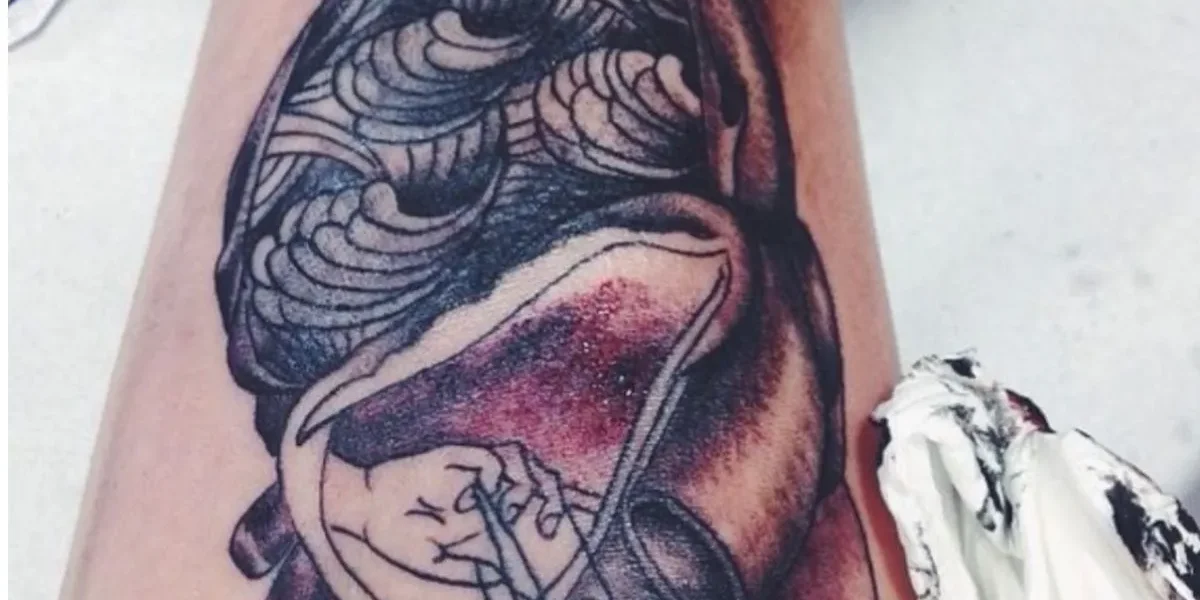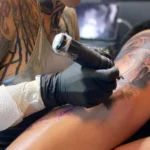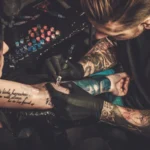Are you a tattoo newbie who just got his first tattoo? If so, you just ventured into body art, probably encountering one of the least glamorous aspects of this process –Tattoo scabbing.
However, don’t freak out, as scabs are a part of the normal healing journey of tattoos. Getting a scab within a week or so of tattooing is normal. The real question is what to do when you do get a scabbing tattoo.
This blog is here to answer all your unanswered questions about tattoos and their scabbing process. Read along to uncover why, what to expect, and how to ensure your ink heals flawlessly. So, let’s begin!
What is Tattoo Scabbing?
Tattoo scabbing is a natural phenomenon of tattoo healing. The typical process of getting a tattoo includes using ink injections and needle pricks subjected to the epidermal layer of your skin. These injections result in multiple traumas to the skin and its layers.
During healing, your body forms a protective layer of dried blood and plasma over the tattooed area. This protective layer is known as a scab, which appears thin and flaky. These scabs serve to protect the newly tattooed skin as it heals.
On one hand, this scabbing can be helpful for the skin. However, it must be remembered that excessive scabbing, thick scabbing, or picking at the scabs can be detrimental to the final appearance of your tattoo.
Causes of Tattoo Scabbing
Although scabbing is a natural way of scar healing in tattoos, many factors can lead to excessive scabbing. Then this abnormal tattoo scabbing can lead to various skin and health problems. Therefore, it is important to identify and address these risk factors beforehand.
Some of the common causes of tattoo scabbing are:
- Allergic reaction to inks
- Excessive skin trauma
- Improper aftercare of tattoos
- Using excessive tattooing ink
- Heavy-handed tattoo artists
- Tattoo bubbling
- Infection
- Too much picking at scabs
The Tattoo Aftercare Guide
Proper aftercare of tattoos is essential to prevent excessive scabbing and wound formations. If your tattoo is scabbing, you can follow these care steps that will help promote healing and prevent infections.
1. Proper Washing the Tattoo Scabbing
Washing the tattoo gently with warm running tap water can help remove the upper hard layer of the scab without eroding it. Use an antibacterial soap to control any infection while washing the tattoo.
For ideal care, wash your tattoo two times a day for the first week. Follow it with once a day wash until it is completely healed. After washing, dry the skin with a clean paper towel or cloth. Do not irritate the skin to cause tattoo scabbing by rubbing it too much.
2. Moisturize
Always moisturize and soothe the site of the tattoo with a mild moisturizer, a thin layer of tattooing balm, or an ointment. Doing so will lock your skin’s moisture and prevent it from hardening too much to form scabby tattoos.
Also, always choose a product that is specifically formulated for tattoo aftercare. Look for ointments or balms that are fragrance-free, hypoallergenic, and free of harsh chemicals, as these can irritate the healing tattoo. Apply the moisturizer gently with clean hands to avoid introducing bacteria to the tattooed area.
3. Wear Loose Clothes
Wearing tight clothing and bandages may cause excessive rubbing and irritation on the scabbed tattoos. It can lead to wound exposure and excessive bleeding.
To avoid this outcome, wear clothes made from soft, breathable fabrics during the initial healing phase of your tattoo. Fabrics like cotton and silk can be used as they are gentle on the skin and can help prevent friction.
4. Avoid Tattoo Scabs Picking
Hard scabs can be irritating and painful at times. Plus, the thick skin over the tattoos is often tempting to pull off by hand. However, this can lead to bigger problems and deeper wounds, let alone a spoiled tattoo. Therefore, avoid picking scabs and allow your tattoo scar time to heal.
Moreover, picking can also increase the chances of infection. In doing so, you expose the underlying skin to bacteria and other contaminants, which can lead to infections that may need medical attention. By being patient and allowing the scabs to fall off naturally, you can boost the healing of your tattoos.
5. Avoid Excessive Physical Activity
Excessive physical activity not only introduces sweat and bacteria to your healing tattoo but can also increase friction and irritation. Therefore, avoid such activities during the initial stage of your tattoo healing.
Allow your tattoo time to settle and adhere properly to your skin. Overly strenuous activities or movements that repeatedly stretch or compress the tattooed area can disrupt healing. It can cause more noticeable scabbing and impact the final appearance of your tattoo in the long run.
Do’s and Don’ts of Tattoo Scabbing
Tattoo scabbing is a natural healing process. It involves a balance between do’s and don’ts that work together to promote healthy and efficient wound healing.
All the detailed guidelines for tattoo care are discussed above. However, here is a bird-eye view of some do’s and don’ts that can help you promote quick healing of your scabbing tattoo.
| Do’s | don’ts |
| Keep your tattoo hydrated by moisturizing it with lotions, creams, or tattooing balms. | Pick the swabs as they can lead to scarring and infection. |
| Wash your tattoo under water or in the shower for a while allowing it to absorb some moisture. | Scratch your scabs. |
| Leave your tattoo alone and let it heal itself. | Rub your scab tattoos. |
| Consult your artist in case of excessive scabbing. | Swim as chlorine in pools irritates your tattoos and delays wound healing. |
| Consult a medical practitioner if the wound gets infected. | Go into direct sun exposure or extreme temperature as it delays wound healing and increases the risk of infections. |
How to Prevent Tattoo Scabbing?
Preventing tattoo scabbing ensures a smooth healing process for your ink and scar. First of all, go to an experienced tattoo artist who uses proper techniques to minimize trauma to your skin.
After getting your tattoo:
- Follow their aftercare instructions regularly.
- Keep your tattoo clean, dry, and sanitized.
- Avoid sun exposure and use high-SPF sunscreen.
- Always let your scabbing tattoos naturally slough off
- Stay hydrated and eat well as proper nutrition helps in wound healing
Lastly, stay patient — your body needs time to heal and settle into that beautiful new tattoo!
How Long Does it Take a Tattoo to Scab and Heal?
Tattoo healing occurs in stages. Scabbing is one of the prominent phases of this healing process. It usually occurs within the first and second week of the healing process.
Your tattoo will start scabbing by collecting the oozed blood and plasma over the skin by the first week. This collection will dry out in a day or two, creating a peeling or flaking skin texture. By the 10th day, the scabbed tattoo had flaked away, leaving the healthy skin underneath behind.
However, bigger tattoos with thicker scabs may take longer to heal. Margaret, a tattoo expert, says, “The single-line trace tattoos tend to flake off after 2-3 days, but heavier and bigger pieces can take up to 3-5 days.”
Moreover, the site of the tattoo also plays an important role in healing scabs. Margaret shares her experience of getting a tattoo on her fingers. “I recall thinking to myself, ‘Why is my tattoo scabbing now?’ after one week. Then I understood the slow healing of the fingers was finally kicking in.”
Do All Tattoos Scab?
No, it is not a statement rule for all tattoos to scab. However, most of the tattoos undergo a degree of scabbing during their healing process. This tattoo scabbing typically varies from person to person and depends upon factors like aftercare, type of tattoo, tattoo size, and location on the body.
The outlined tattoos without the inner inkings have lesser area subjected to trauma, so they are less likely to scab than those with inner inks. Moreover, the location of a tattoo can affect scabbing, too. Areas with more movement or friction, like joints, tend to scab more due to increased skin stress during healing.
Furthermore, tattoos that are bigger and heavily detailed are more prone to tattoo scabbing than smaller tattoos. It is because of a greater degree of skin trauma induced during the process of tattooing. Lastly, the scabbing of your tattoo also depends greatly on your aftercare. All these factors combine to promote the scabbing of a tattoo.
What is Healthy Tattoo Scabbing?
Healthy tattoo scabbing refers to the natural tattoo healing process, which includes the formation of thin, dry scabs over the tattooed area. These scabs are usually minimal, protecting the newly tattooed skin as it heals.
This scabbing occurs when your body’s natural healing response kicks in to repair the skin damaged during tattooing. The scabs are composed of dried blood plasma and tissue fluid, which create a protective barrier against potential contaminants and bacteria. They also help to keep the tattooed area moist and promote the regeneration of skin cells.
How Much Scabbing is Too Much Scabbing?
Light pink discoloration of the skin for one or two days and flaking off of the skin is the normal way of the tattoos to scab. However, too much scabbing can be concerning if it covers the entire tattoo, is exceptionally thick, or persists beyond the initial healing stages.
Excessive scabbing may indicate an issue with the healing process. Therefore, it should be addressed and discussed with an artist or a dermatologist as soon as possible.
If you find yourself having any of these abnormal tattoo scabbing signs, immediately get an examination and a consultation:
- Swelling of the tattoo site
- Redness of the skin around
- Increasing pain
- Plasma and blood oozing after 48 hrs
- Pus coming from the crusts
- Raised skin around the edges
- Hardening of the tattoo
- Fever
These signs may indicate an infection that can lead to other harmful outcomes. Therefore, always seek medical attention in such cases.
Tattoo Scabbing vs. Tattoo Infection
Tattoo scabbing can go wrong if it leads to tattoo infection. Most people confuse these two terms interchangeably. However, in a real sense, both of these are the opposite ends of the same healing spectrum.
As discussed above, scabbing of the tattoo is a benign part of the healing process that occurs in the days following a tattoo. It is found at the positive end of the healing spectrum of tattoos.
However, if this scabbing gets subjected to improper care and healing, it may get infected, which is a more serious concern. Tattoo infection is commonly found at the negative end of the healing spectrum. The infectious tattoo wound can be identified by the following signs and symptoms
- Excessive redness
- Swelling
- Inflammation
- Hotness of the skin
- Rash
- Itching
- Bumpy skin
- Oozing pus
- Severe pain
- Gangrene
- Fever
- Shivering
When To Contact a Doctor
It’s essential to keep an eye on your healing tattoo. If you notice unusual or concerning signs of scabbing, it’s wise to consult a doctor. It’s your sign to see a doctor if your tattoo is covered in thick greenish or yellowish discharge. Or if there is an offensive smell coming from your wound.
Moreover, these could be signs of an infection or other complications if you’re experiencing severe pain, excessive bleeding, or persistent scabbing beyond the initial healing stage (usually a week or two).
Additionally, don’t hesitate to see a healthcare professional if you notice spreading redness, intense itching, or signs of an allergic reaction like hives, rash, or difficulty breathing. Your health should always come first; prompt attention can prevent more serious issues and ensure your tattoo heals properly.
Final Thoughts
The idea of getting a tattoo is exciting and thrilling. However, understanding the scabbing process as part of tattoo care is essential for anyone new to the process of tattooing.
Following the aftercare tips outlined in this guide will make sure that your new tattoo heals perfectly fine and retains its vibrancy.
Remember that proper tattoo scabbing healing takes time, and patience is key. Always listen to your tattoo artist’s advice, resist the temptation to scratch or pick at scabs, and consider using specialized itch relief creams if needed. Your tattoo is a work of art that deserves the best care. By implementing these tips, you’ll be well on your way to enjoying your ink for years.
Tattoo Scabbing Frequently Asked Questions (FAQs)
Should I moisturize a scabbing tattoo?
Yes, it would be helpful to moisturize your scabbing tattoo, as it will help the skin to hydrate and regenerate. The hydration, in turn, promotes the healing potential of the tattoo.
Should I put anything on a scabbing tattoo?
Yes, it would help if you used lotion, soothing ointments, or tattoo cream on your scabbing tattoo to moisturize and keep it healthy. It helps in wound healing of your tattoo scab.
How often should I moisturize a scabbing tattoo?
A tattoo scab should be moisturized twice to thrice daily for up to 2 weeks. It will help to soothe the scab scars and help to prevent any dryness of the skin, aiding in easy peeling and flaking off of the skin.
How long can tattoo scabbing last?
The tattoo scabbing phase typically lasts a week to ten days. Your tattoo will dry out, peel off, and flake off during this time. However, thicker tattoo scabs usually take longer than 10 days to flake off and heal properly.
Do you wash your tattoo when it’s scabbing?
Medically, washing your tattoo when it is in its scabbing phase is not advised. Therefore, all the activities like long baths or swimming should be avoided. Excessive moisture can irritate the tattoo and delay the wound healing. However, for thick scabs, it is advised to soak them in water to soften them up. It helps in the easy peel-off of the tattoo.
Why is there no ink under my tattoo scab?
Normally, tattoos go through a peeling process as they heal, and it’s common for a tiny bit of ink to come off during this. In rare cases, there might be some areas without ink. But tattoo scabbing with a little missing ink is not a big concern.
Can I wear clothes over a scabbing tattoo?
Yes, you can wear clothes over your scabbing tattoos. However, opt for loose clothes, allowing air to cross through and breathe. Clothes that have a tight fit, such as sportswear, are not a good option as they rub against the tattoo marks and cause irritation of the scabs.
How long do scabs take to fall off?
Scabs usually drop off independently, which can take a few days to a few weeks, depending on the wound’s size. It’s better to prevent scabs from forming because they slow down your skin’s healing by interrupting the growth of new skin.




